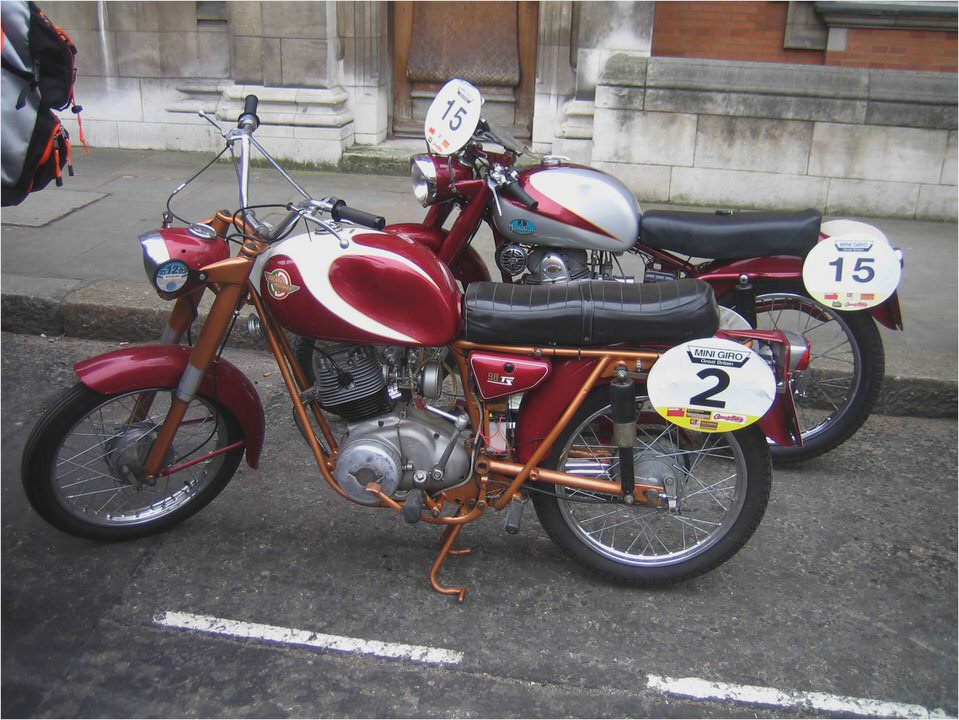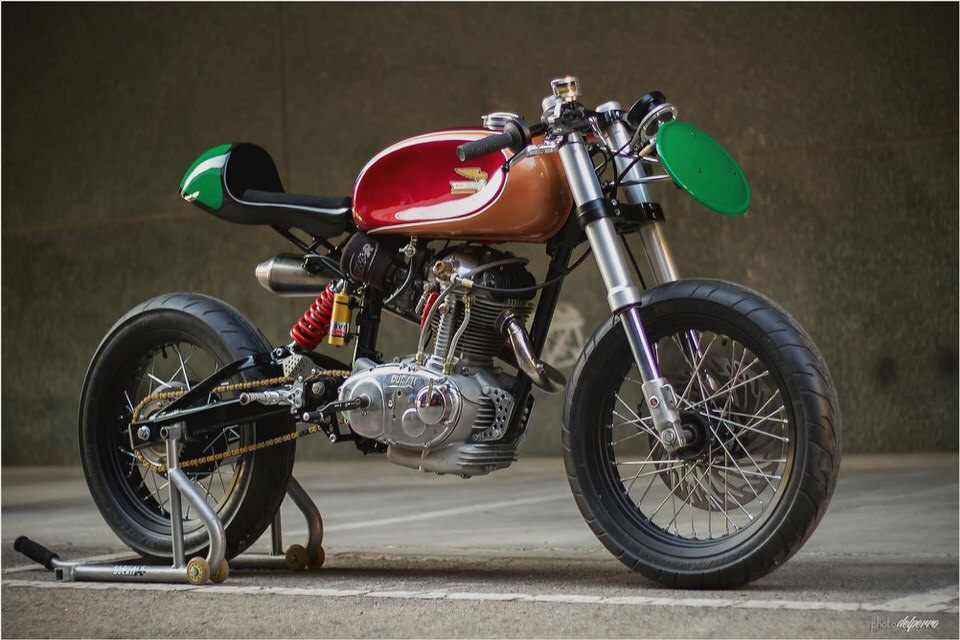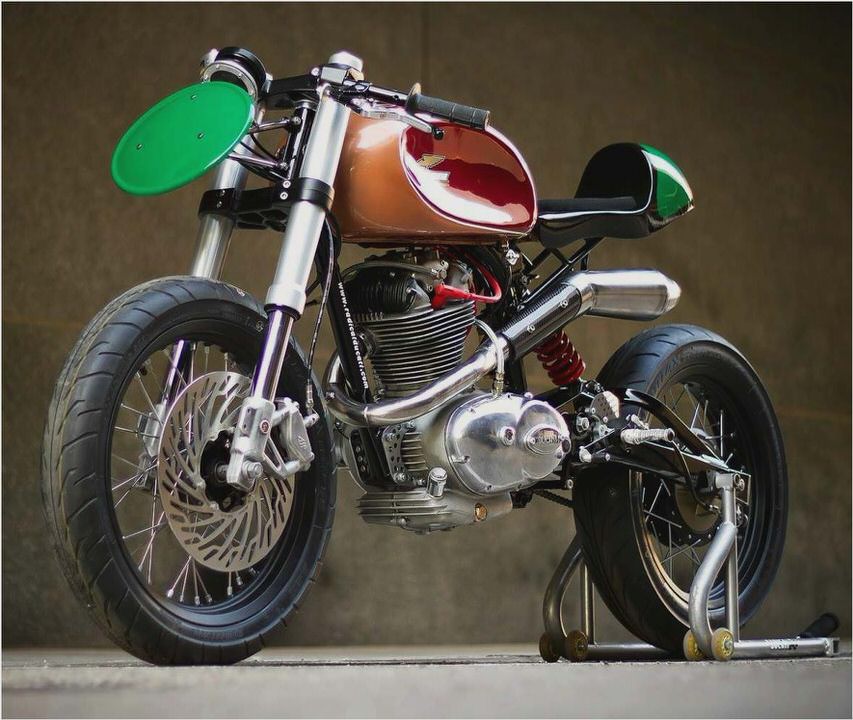
Classic Vintage Motorcycles: Ducati Motor Holding, SpA
Ducati History
All Web Site Content – Copyright 2009 TheWorldOfMotorcycles.com
The Ducati motorcycle company began as Societa Scientifica Radio Brevetti Ducati founded in 1926, by brothers Adriano, Bruno Cavalieri, and Marcello Ducati from Borgo Panigal Bologna, Italy. Ducati began by manufacturing radio components, diversifying into motor-driven bicycles shortly after WWII.
A company called Societa Italiana per Applicazioni Tecniche Auto-Aviatorie (SIATA) began producing small single-cylinder engines designed to be mounted onto a bicycle frame. The engines were dubbed Cucciolo , or little puppy for the unusual exhaust-note emanating from its short exhaust pipe.
At the end of WWII, businesses like Ducati and SIATA fell under the jurisdiction of the IRI (Institute for Industrial Reconstruction), a governmental agency that co-managed large industrial companies.
Ducati Singles (1950 to 1973)
With the success of the Cucciolo engine, Ducati decided to partner with SIATA to produce its first small-displacement motorcycle in 1950. The first Ducati was called the was 55M (65TL), and featured a 60cc pushrod engine that produced a top speed of 40 mph.
The Ducati 100 Gran Sport
The limited production 1954 100 Gran Sport was designed by Fabio Taglioni (Dr. T), founder of the now-defunct Ceccato Motorcycles. The Gran Sport had a 98cc single-cylinder engine with a OHC overhead-cam driven by a vertical shaft with conical gears, and a 10ј forward tilt to the nearly vertical cylinder head.
The Gran Sport’s single-cylinder OHC engine design was the precursor for two decades of engine production at Ducati.
In 1953, ‘Societa Scientifica Radio Brevetti Ducati’ was broken into two separate companies: Ducati Elettronica SpA, and the motorcycle division of Ducati Meccanica SpA. Fabio Taglioni was elevated to chief designer of Ducati Meccanica in 1954, and his Gran Sport was upgraded to a 125cc double overhead cam (DOHC) engine in 1956.
100cc Gran Sport Engine
As the popularity and performance of Ducati motorcycles grew with Italian enthusiasts, they set out to position itself as a race-worthy marque.
The Ducati Desmo (Desmodromic) Engine
To develop higher horsepower race-capable engines with such small displacement, it was necessary to significantly increase the rpm range of their racing motors. The 125cc Gran Sport engine was capable of safely hitting the 11,500 rpm range, without producing enough valve-float to collide piston with valve.
The principle of mechanically ‘forcing’ the valve to close, and not relying totally on a valve-spring, was first conceived in the late 1800s, but was not put into practical use until the 1930s. This mechanical valve system became known as desmodromics , which is Greek for desmos . meaning ‘controlled,’ and dromos . meaning ‘course.’
Milan-based motorcycle company Mndial toyed with the idea of a desmodromic engine in the early 1950s, but soon abandoned the idea. Ducati first developed their own version of a desmodromic, or Desmo valve system in 1956, using the design on their 125cc Grand Prix race bike. The 125cc Desmo was capable of reaching a maximum 14,000 to 15,000 rpm range, thereby creating higher horespower.
The 125cc Ducati Desmo proved to be a race-worthy competitor to the MV Agusta. which had previously dominated the 125cc GP class.
During the 1950s, America’s newfound interest in Italian marques such as Ducati had prompted two brothers named Joseph and Michael Berliner to open the first Ducati franchise in the United States – the Berliner Motor Corporation of New Jersey. Berliner was soon able to exert a great deal of influence in the design of new models that were destined for the American consumer.
In the late 1950s, Ducati introduced the 125 Monza and Monza ‘Super,’ and Ducati was now trying to squeeze as much horsepower as possible out of their 125cc engine, with their retail competitors moving to higher displacement engines.
Fabio Taglioni steadily increased the reliability, displacement, and power of Ducati’s single-cylinder engine using faster cams, high-compression pistons, and Dell’Orto SS racing carburetors, helping Ducati to win several Grand Prix championships over the next decade.
The Ducati 250cc Mach 3 Diana
Ducati moved into the 250cc displacement category in the early 1960s, with the introduction of the ‘Ducati 250’ and Mark 3 (Mach 3) ‘Diana’ Super Sport.
Moving up the displacement ladder, Ducati introduced its first 350cc production motorcycle in the mid 1960s, which was called the ‘350 Sebring.’ By this point, US Ducati importer Berliner was pushing for the reluctant company to start producing larger displacement twins that could compete with Indian and Harley Davidson .
In 1967, the Italian government took over the day-to-day operations of Ducati through the holding company known as EFIM ( Ente Partecipazioni e Finanziamento Industria Manifatturiera ), which now controlled over 114 industrial companies within Italy.
By 1967, Ducati Meccanica SpA produced its first production desmodromic (Desmo) consumer model, the Mark 3D. The Ducati 450 cc motor was the company’s largest displacement model to date. Unfortunately for Ducati, the non-Italian buying public was looking for 2-cylinder larger-displacement motorcycles, and Ducati would need to change with the times to survive.

The Ducati Apollo
By the mid 1960s, the Berliner brothers helped to underwrite the development of Ducati’s first multi-cylinder engine. The bike, having a launch date of late 1965, was to be named the Ducati ‘Apollo,’ featuring a 1256cc 90ј V-four engine, with two valves per cylinder. With over 100 bhp, it would have been one of the most powerful motorcycles of the time.
Unfortunately for the Berliner brothers, the Italian government’s EFIM management nixed the project, however the development of the Apollo’s engine did lead to the development of smaller displacement 90ј V-Twin engines in 1970. Ducati’s unusual positioning of the V-Twin lead to it being referred to as the L-Twin.
Ducati Twins (1970 to Present) – V-Twin 750GT
In 1970, Ducati’s first v-twin engines were designed primarily for use in Grand Prix racing. Working with Italjet founder Leopoldo Tartarini, Fabio Taglioni designed and built several 500cc V-Twin racing Ducatis.
The Ducati 750GT 860GT
The first production v-twin was the Ducati 750GT, with bevel-gear driven two-valve cylinder heads, fibreglass gastank, and painted silver frame. The 750GT evolved over the next decade to be sold as the 750 Sport, 750SS, 860GT GTS, 900SS and Mike Hailwood Replica.
Ducati engineers moved to a belt-driven double overhead camshaft (DOHC) system for their GP bikes in 1973. The belt-drive engines were distinguished by their a radial-finned forward cylinder head.
The Ducati ‘Pantah’ Series
Ducati’s first use of the belt-driven camshaft in a production motorcycle came in 1980, with the 500cc Pantah 500SL. The Pantah engine’s belt-drive would be the precursor for all Ducati v-twin engines to come. The Pantah also featured the first use of the now signature trellis frame, which incorporated the engine/transmission as a stress member, and swingarm pivot point.
The Pantah engined series lasted for six years under the model names: 500SL, 600SL, 600TL, 650SL and the 750 F1 series which was the last of the Pantah line in 1986. The F1 was one of the premier superbikes of the 1980s, which were followed by the 4-valve 851 series.
The 750 F1, first released in 1985, was designed by Taglioni, and was the first production Ducati to use the Verlicchi-style trellis frame with mono-shock rear suspension. The F1 used fully-floating front and rear disc brakes.
Cagiva’s Purchase of Ducati
The Ducati 851 Desmoquattro


- Tyre Size – Ducati Up North
- Ducati 851 Road Test – Classic Motobikes – Bike Reviews
- DUCATI SS 350:
- Total Motorcycle Website – 2005 Ducati Superbike 749 Dark
- 2014 Lexus GS 450h Review – Watch CNET’s Video Review
